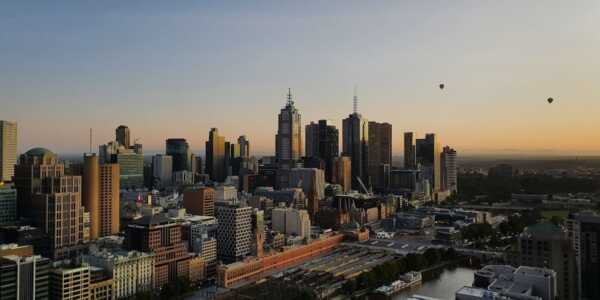“Dig for Victory” was a World War II homefront battle cry, and Victory Gardens were hailed as a solution to drought, labour and import shortages as the war raged on.
But after the war, the ability to grow your own food in the area in which you live, whether in allotments or back gardens, gradually fell by the wayside.
“Ironically, I think we probably did agricultural neighbourhoods informally in the past a lot more than we do now,” says John Doyle, associate dean of architecture at RMIT University.
But new developments are revisiting this old idea.
RMIT is exhibiting a proposal for an urban farm in North Melbourne as part of Melbourne Design Week in May 2024, and there are plans in the works for a Cairns ‘agrihood’ —integrating new housing development with farming uses.
“The idea of agricultural neighbourhoods is very scalable…an agricultural neighbourhood could be something as simple as a suburb in which households grow produce in their backyards.”
Challenges of farming in high-density environments
One of the most popular models in Australia is the community garden. City farming organisation Community Gardens Australia listed 700 gardens in its national online directory in 2023.
Developer-led examples include Brunswick Group’s Six Degrees Architects-designed West Melbourne apartment development that features a food-waste system, rainwater tanks and a communal rooftop garden, while Nightingale’s Fairfield project [pictured above] has a shared rooftop with veggie patches.
But models of agriculturally focused built environments are varied.
“It’s easy to integrate agriculture into low-density developments such as detached or semi-detached housing which includes backyards or common gardens,” says Doyle, who has a PhD in architecture and design.
“The issue here is really around articulating a value proposition for giving up saleable land for the common good but many planning schemes require public open space or common space.”
But there are many challenges when integrating agricultural components into developments and often management structures can be problematic.
“Design can accommodate agriculture but the operation of these spaces fail to work if there is not some way to ensure access, upkeep, maintenance [and so on].”
Management issues have caused earlier projects to invest in communal garden or high-density farming projects. Melbourne’s Queen Victoria Market garden, for instance, aimed to provide a functioning greenhouse with crops and aquaponic systems but resistance from stakeholders prevented it moving further.
There are also structural concerns, especially for communal gardens in high-rise buildings.
“Where soil and water is involved, there is cost and complexity in building gardens into building structures,” Doyle says.
“Often roof gardens can lead to water ingress issues and will need to be frequently maintained. Wet soil is heavy and consequently requires a large amount of structural support, which can drive cost.”
But even though it might not immediately add up, as is the case with vertical farming, there is the opportunity at this early stage in Australia’s urban agriculture journey to shape the future.
“In some cases developers can receive financial or yield incentives for including green space in their proposal,” Doyle says.
“We’re super interested in the challenges of including farming in high-density urban environments precisely because of the difficulty.
“From what I've seen in Australia it hasn’t been considered properly yet, which means there is the opportunity to shape policy.”
Across the globe
While food security is not necessarily an immediate concern in Australia given that we are a net exporter of food, urban agriculture can connect consumers with food sources and help to take advantage of ‘leftover’ space in cityscapes.
“Food production spaces can be added to leftover spaces in buildings not appropriate for habitable areas—this is particularly useful for adaptive reuse projects,” Doyle says.
“We completed a project in 2017 looking at the adaptive reuse of carpark spaces in Hong Kong into vertical farming—I see this idea has since been taken up by a few people in Melbourne.
“A similar idea could be applied to the retrofit of commercial buildings into apartments—rather than having deep apartments with no natural light, as was the case with commercial tower adaptations in the 1990s, the centre of a commercial floorplate could accommodate food production, allowing the apartments to be thinner and concentrated around the perimeter of the floor plate.”
International examples can light the way, with large-scale greenhouse production in the Netherlands and Spain, and in Asia and the US, brownfield sites within metropolitan areas provide space for large-scale sheds.
From a pragmatic point of view, developers in need of a point of differentiation can utilise shared community gardens as a marketing tool, and in other countries, agricultural elements to developments have been gamechangers in planning.
“We can learn from Europe where the EU is exploring policy and incentives to allow for small-scale food production to occur in cities,” Doyle says.
“We could look to this approach as a way of supporting and strengthening what is already happening and ensuring that as the city densifies that the characteristics of the Australian suburb are not erased.”
This becomes more important as Australian cities reach their sprawl limits.
“We are facing dual challenges of decarbonisation and housing affordability,” Doyle says.
“These challenges will mean our cities will need to be consolidated. An outcome of this could be an increased desire for the kinds of amenities we enjoyed in the traditional suburb—such as small scale agriculture—appearing in high-density developments.
“Agriculture spaces can be a way of creating developments that are enjoyable to live in, and provide for connected communities.”
Author - Clair Burnett, The Urban Developer









